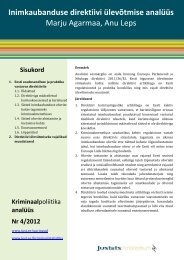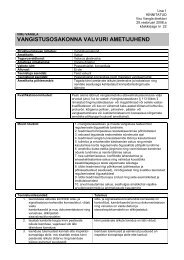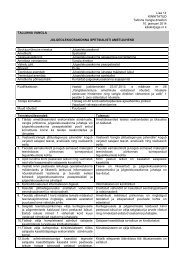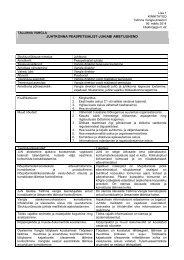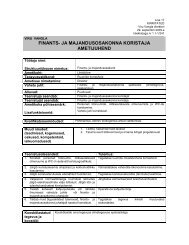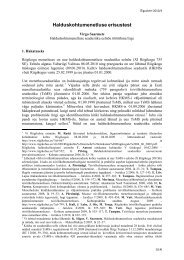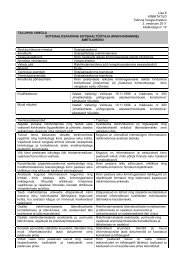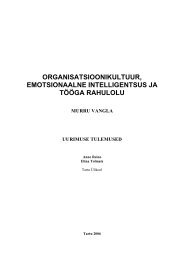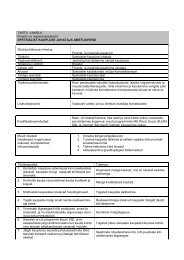11. Retsidiivsus Eestis - Justiitsministeerium
11. Retsidiivsus Eestis - Justiitsministeerium
11. Retsidiivsus Eestis - Justiitsministeerium
Create successful ePaper yourself
Turn your PDF publications into a flip-book with our unique Google optimized e-Paper software.
RETSIDIIVSUS EESTIS 2010<br />
4. CHARACTERIZING FEATURES OF PEOPLE RELEASED FROM PRISON<br />
RETSIDIIVSUS EESTIS 2010<br />
4.4. Prison activities of people released from prison<br />
In prison the prisoners may be engaged in various housework, production<br />
work and learning offered by a prison or participation in social programmes. A<br />
person released from prison was considered as engaged in activities during the<br />
time held in prison, if he/she was associated with such activity immediately<br />
before release from prison.<br />
Social programmes have been implemented in prisons since 2001 and at<br />
present ten programmes are in use. Their objective is to influence the views<br />
and behaviour of prisoners and develop self-control skills in order to improve<br />
prerequisites for coping after release and refraining from new criminal offences.<br />
For example, in anger management programme it is learned to recognize and<br />
control one’s anger reactions and replace them by acceptable behaviour; the<br />
orientation of aggression replacement training is also similar. The purpose of<br />
programmes designed for prisoners with dependency problems is to decrease<br />
alcohol dependence or drug addiction. There are special programmes aimed<br />
at people repeatedly punished for drunk driving and sex offenders. In recent<br />
years, the possibilities of learning in prison have been expanded.<br />
Prisoners’ engagement with work, studies and/or social programmes has<br />
considerably increased in 2007-2007; when only 27% of people released from<br />
prison in 2004 were engaged in activities, then in 2007 already 52% from<br />
people released.<br />
4.5. Bases for the release from prison<br />
This study observed people released from prison as convicted offenders who<br />
were released due to having partially or fully served their sentence, premature<br />
release or pardon (See description of methodology in the beginning of<br />
chapter). At this point it has to be taken into consideration that the structure<br />
of bases for release cannot be precisely compared, although general trends<br />
can be observed: since the beginning of 2007, conditional release from prison<br />
under electronic surveillance became possible; the hearing of premature<br />
release of prisoners in court became also obligatory after the expiry to term<br />
prescribed by law and with this it was no longer necessary for the prisoner to<br />
apply for it himself/herself62.<br />
During 2004-2007, the number and proportion of people who had fully<br />
served their sentence among people released considerably decreased; when<br />
four fifths (82%) were released in 2004, then already less than half (49%)<br />
in 2007; also the number of people released within a year reduced by more<br />
than 500. At the same time, the proportion of prematurely released people<br />
increased from 18% to 38% and the number of people released on that basis<br />
increased by more than 600. Such development was made possible first of<br />
all by the strengthening of probation supervision system and consequently<br />
more active recourse of prisons to the court in order to consider the premature<br />
release.<br />
Table 7. Engagement in activities of people released from prison by year of release<br />
(number and %)<br />
Number<br />
Proportion<br />
2004 2005 2006 2007 2004 2005 2006 2007<br />
Was engaged 608 838 989 1391 27,0% 32,6% 41,8% 51,7%<br />
Was not engaged 1645 1736 1376 1302 73,0% 67,4% 58,2% 48,3%<br />
The level of engagement in activities has been the highest in case of minor<br />
prisoners, exceeding 50% for all people released from prison. After 2004, the<br />
proportion of people engaged in prison activities has considerably increased<br />
for people who started their prison sentence as adults, especially in the 18-25<br />
age groups. During the observation period, the level of engagement in activities<br />
of older prisoners also increased and differences between age groups<br />
diminished.<br />
Table 8. Basis for release of people released from prison by year of release (number and %)<br />
Number<br />
Proportion<br />
2004 2005 2006 2007 2004 2005 2006 2007<br />
Release after serving<br />
full sentence<br />
1839 1689 1588 1319 81,6% 65,6% 67,1% 49,0%<br />
Premature release 409 559 572 1035 18,2% 21,7% 24,2% 38,4%<br />
Premature release with<br />
electronic surveillance<br />
x x x 181 x x x 6,7%<br />
Release after serving<br />
shock imprisonment<br />
1 321 200 156 0,0% 12,5% 8,5% 5,8%<br />
Pardon 4 5 5 2 0,2% 0,2% 0,2% 0,1%<br />
TOTAL 2253 2574 2365 2693 100% 100% 100% 100%<br />
62 In addition, an amendment to the Penal Code which entered into force on 15 March 2007 with which offences<br />
against property involving objects or proprietary rights of small value were decriminalized and this provided an<br />
opportunity for people who have been previously punished for such an act for premature release. These people were<br />
released “on other bases” and these are not taken into consideration here.<br />
196<br />
197



